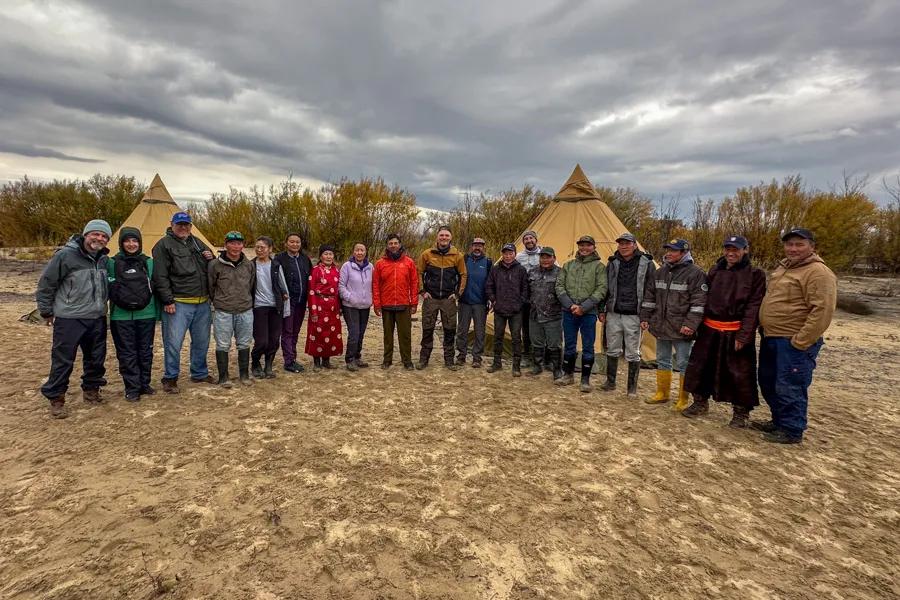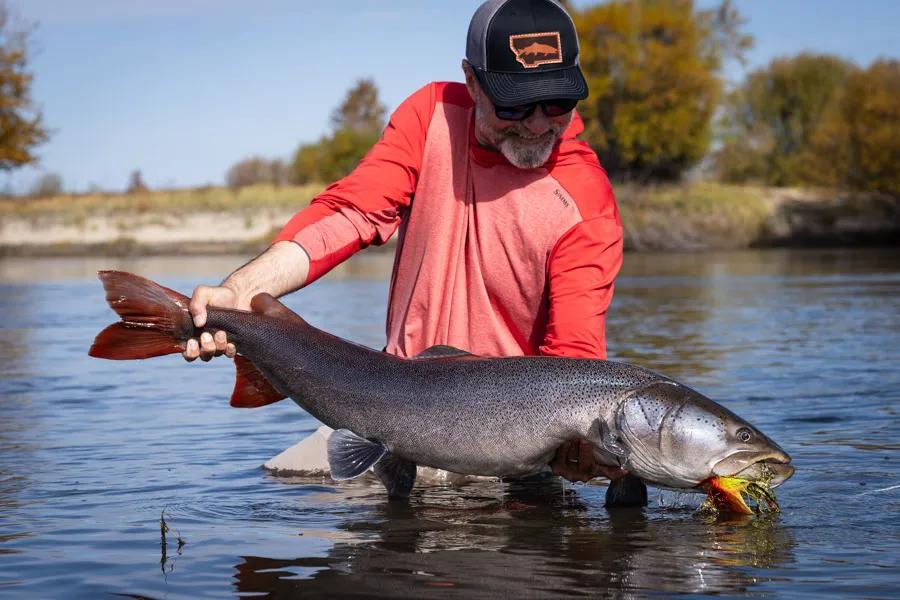
Is there another progressive fishing and camping river trip on the planet that can upstage a Mongolian fly fishing adventure? I don’t think so. Where else in the world can you listen to Asian elk bugling and wolves howling at night and then switch gears to chase both the world’s largest trout and pike that regularly surpass 40” with some monsters over 50” caught every year?
Our 2025 hosted trip to fly fish in Mongolia on a remote river in the wilds of northeastern Mongolia easily surpassed all expectations. I was very excited for this adventure as we would be floating a new section of the river that I hadn’t seen yet. The majority of the Lower River float travels through an expansive National Park. This remote region is just south of Siberia and the Russian border. Our trip was to spend 7 days progressively camping and floating over 100 miles of water. Exotic gamefish including taimen, amur trout, lenok and grayling would await.
The previous year with Mongolia River Outfitters we fished the upper most section of the same river system which was also an amazing trip. The Lower River is even larger as more tributaries join. The landscape is similar to the reach we floated the year before with open planes, river canyons and timbered mountains. We have the river to ourselves on these trips with only 6 anglers per trip and our partner outfitter is the only permitted outfitter.
Mongolia River Outfitters runs an exceptionally well organized program with excellent communication, great fishing guides, and well-equipped camps run by their attentive camp teams. In the summer the same camp teams operate on an alternative river system to the west and then in the fall they run 3 more trips to the east. These programs are so special because the most fishing pressure these fisheries experience is 3 trips only per river section total over the entire year. Each section of river only gets fished 3 days out of the entire season by MRO guests!



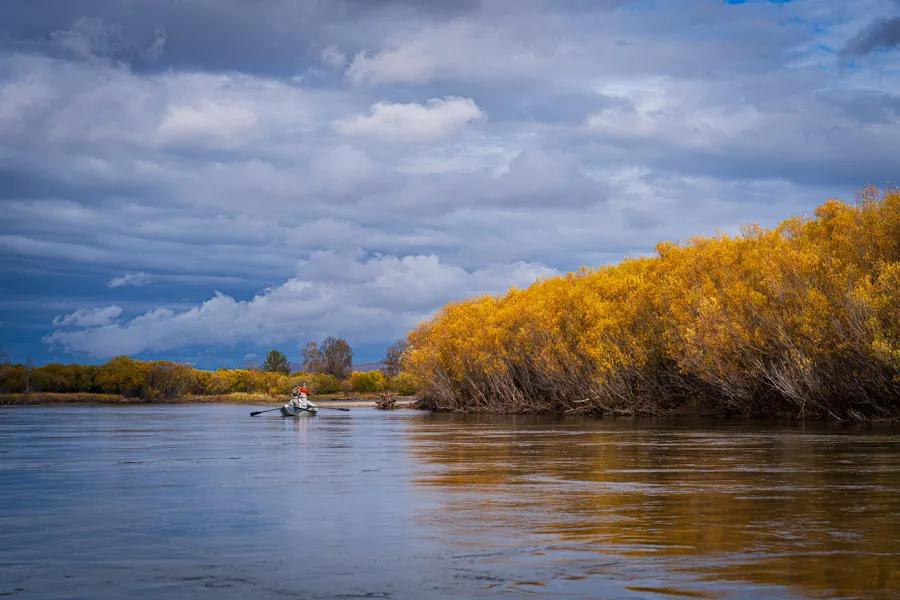
Getting There is Part of the Adventure
There are no direct flights from the United States to Ulaanbaatar, Mongolia’s capital. The most common route is a direct flight to Seoul, Korea followed by a 2.5 hour flight to “UB”. On this trip my 13 year old daughter Lily was along so we opted to fly through Tokyo, Japan to spend a few nights soaking up big city life. We opted to stop over in Japan for three extra nights to do a little touring.
The trip price includes the arrival night Ulaanbaatar. It is easy to add an extra night, which is what our group opted to do. Ulaanbaatar features a blend of past legacies of Soviet error architecture with the vibrant new growth of a thriving capital city. Mongolia is rich in natural resources and the country is investing in the capital city as new office and apartment buildings are actively being constructed. Arriving a day early allows for a tour of the city to see museums, cultural sights, and even some shopping for local cashmere clothing.
Our Mongolian wilderness fly fishing expedition truly began when our drivers met us in the early morning at the hotel. With them as drivers and tour guides we trekked across northeastern Mongolia. Along the way we took a quick stop at the impressive “Chinggis Kahn” statue. Almost half of all Mongolians live in UB and once you leave the city you realize just how vast and remote Mongolia is. While driving across the famed Mongolian Steppe you see herds of goats, sheep, cattle, horses, and camels on the open range. Mongolia by national decree allows most of the country’s landscape to be used by nomadic herders. This traditional way of life is still thriving and even in the most remote regions “ger” camps can be seen in the distance along with groupings of animal herds. A ger is a Mongolian yurt with thick felt walls covered in canvas. There are no fences on the pastures of the Steppe and the nomadic herders move their ger camps a few times of year to follow their animals.
After a long 12 hour drive we arrived at our first camp along the river Most of Mongolia River Outfitter's camps are ger camps and MRO sets up about 15 of these camps on the Upper and Middle sections of the river. We arrived in time for a filling and delicious dinner and afterwards some enjoyed some spectacular star gazing. Because of being so far from civilization, this area of Mongolia features some of the greatest star-gazing on the planet.
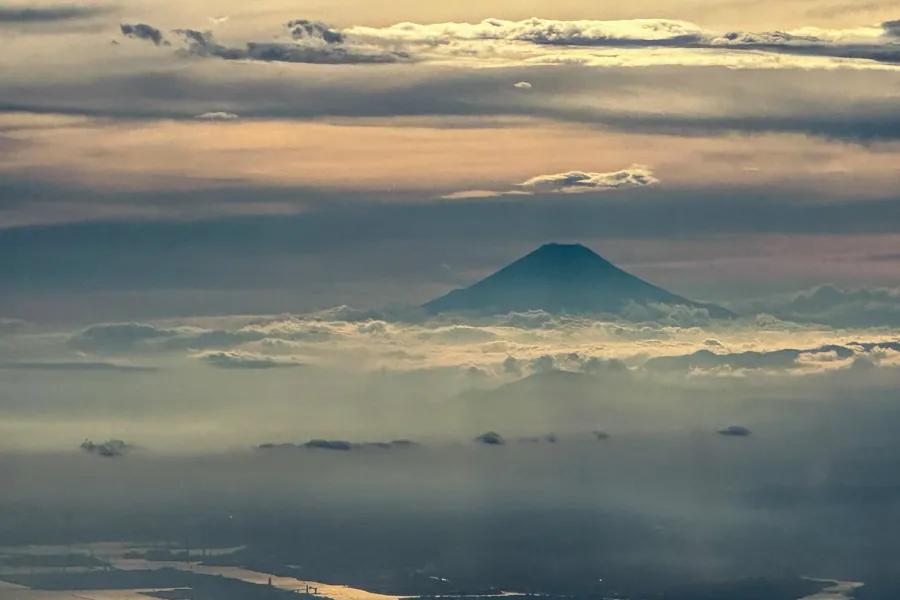

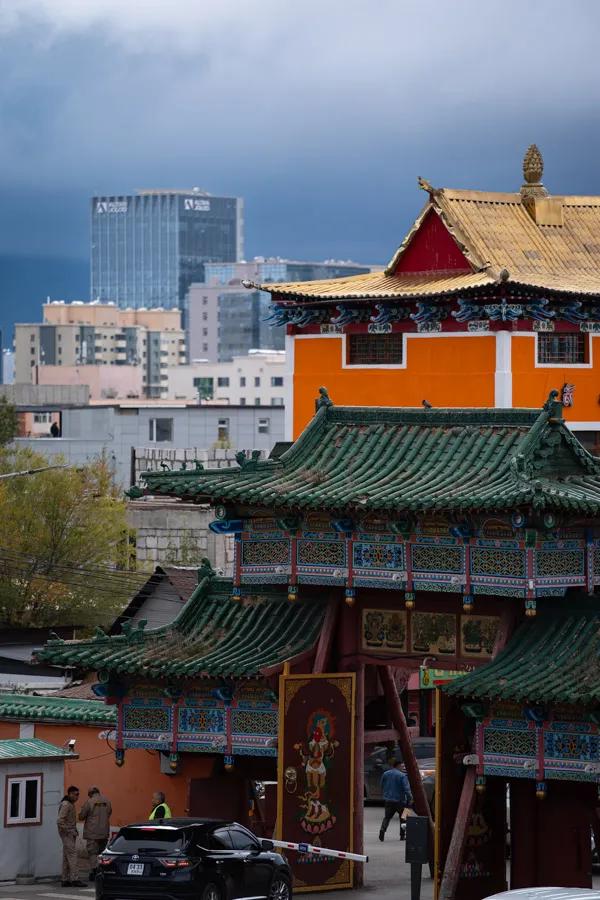



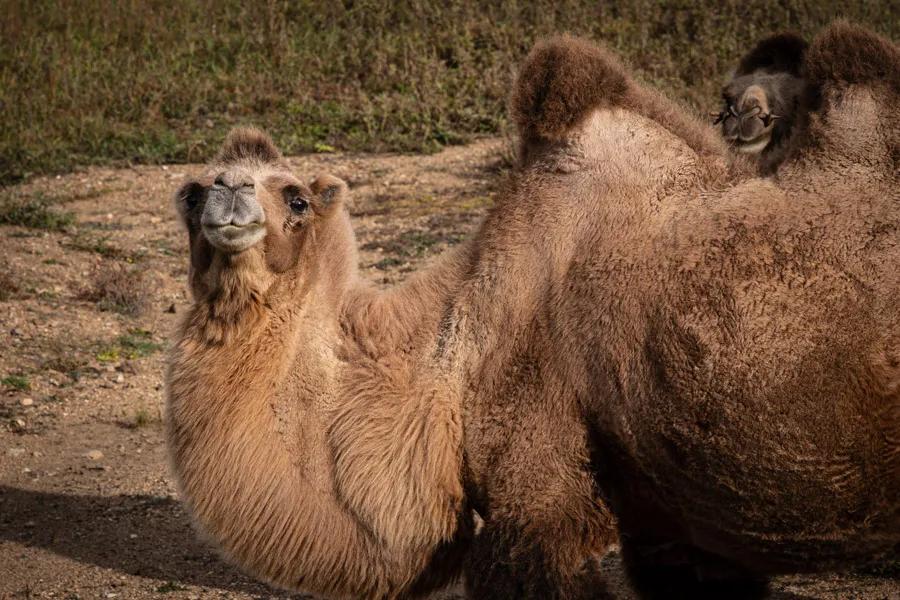

The National Park
The large natioanl park that we floated through is in the northwestern corner of Mongolia just south of Siberia. This is the home of the legendary emperor Chinggis Kahn (sometimes referred to as Genghis Kahn in the West). Nearly our entire trip over the course of 7 days was spent inside of the park. This is an incredibly wild part of the country and almost every night of the trip we listened to wolves howling and the Maral stag (or Asian elk) bugling. Midway through our trip we watched one of the huge elk swim the width of the river. The Maral stag are much larger than the red deer in Europe and are very similar to our Rocky Mountain Elk here at home.
As we floated down the river the scenery changed and ranged from open valleys to tight canyons with towering cliffs. The mountains looked somewhat similar to those in Montana with a blend of timber and meadows. We arrived at the peak of fall colors and the aspens, larch, and cottonwoods were bright yellow while smaller shrubs were a fire red color.
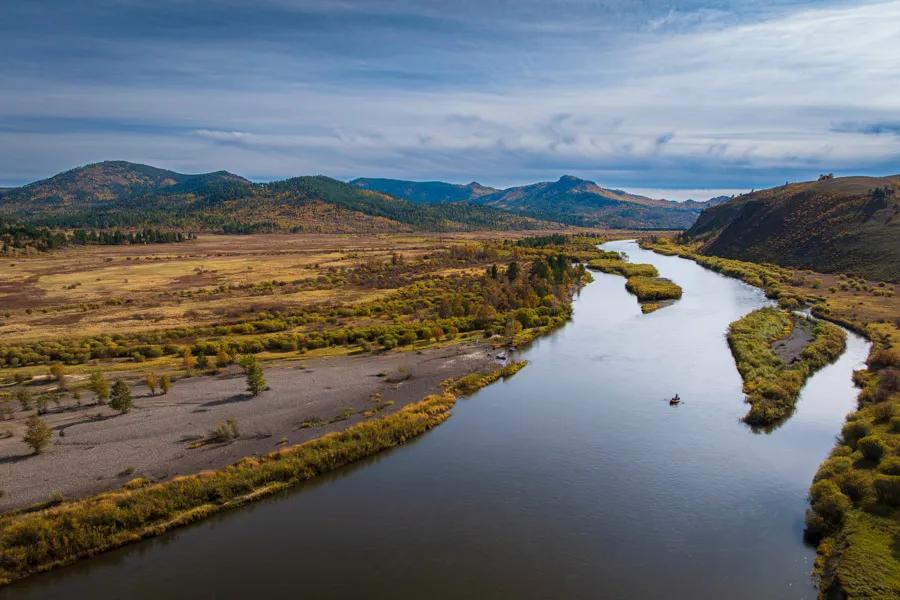
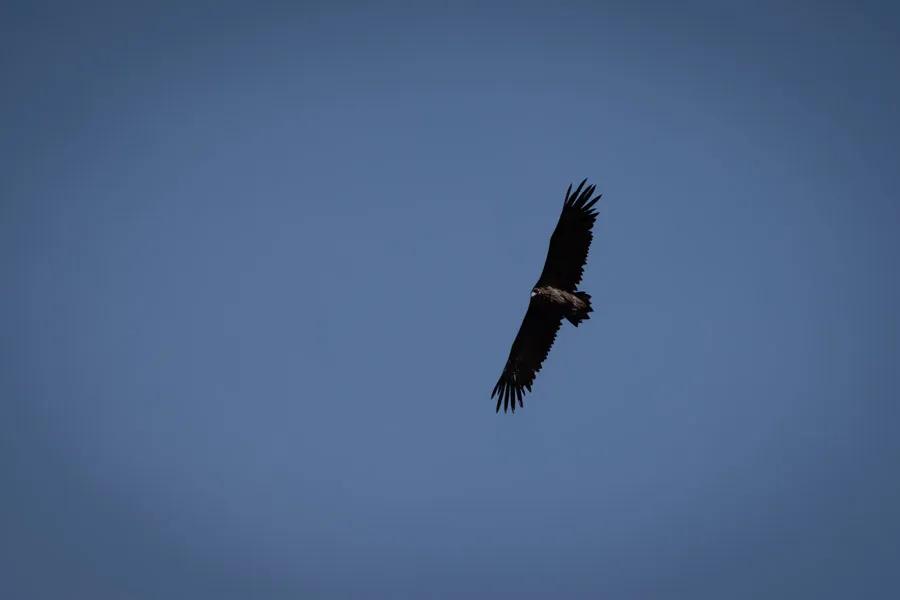
Life in Camp
The MRO team has been running these remote river camps for well over a decade and they have it completely dialed in. There are only two programs in Mongolia for travelling anglers to experience taimen fishing in Mongolia and Montana Angler partners with both Mongolian fly fishing outfitters.
The taimen fishing licenses for non-residents are very limited and only 100 anglers per year are permitted to fish the river. With almost 300 miles of water on the river is broken up into three large reaches. Each reach takes 7 days to cover while progressively floating and camping down the river. On most of the river system the traditional ger tents are used for the client sleeping tents, kitchen tent, and lodge tent. These are set up for the entire season and remain in place while the bedding and kitchen equipment is floated from camp to camp every day.
On the lower section when floating through the National Park the camps must be completely removed every night. In this reach large canvas teepes outfitted with rugs, cots, and sleeping bags are used. The cots are made up like beds with pillows and several cashmere blankets.
Two large toilet tents are set up each evening. There is also a shower tent complete with wood burning stove, hot water, and a battery operated pressurized shower head. The entire camp is broken down every day and moved down the river in 5 large gear boats. A 6th raft is used as the lunch boat and every day on the water we enjoyed a hot lunch that was grilled on a picturesque gravel bar.
Chef Katya was outstanding and our crew raved about the food each evening. Dinners were always a great part of the evening with guests and guides converging in the warm lodge wall tent heated by a wood burning stove. Mornings provided hot coffee, pancakes, eggs, and a variety of other hearty accompaniments before departing on the river.
I know just how much work it takes to operate river camps. I’ve spent over 30 years guiding and overseeing operations of our own river camps here in Montana on the Smith River and other backcountry waters. These are equipment intensive programs and there are lots of fine details required to pull them off seamlessly. The MRO camps are very well done with lots of attention to detail.


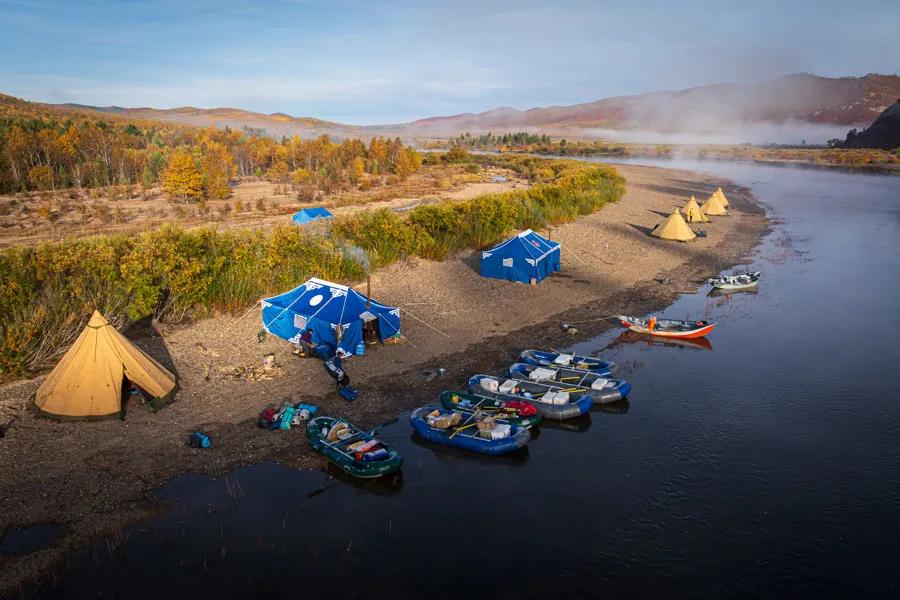


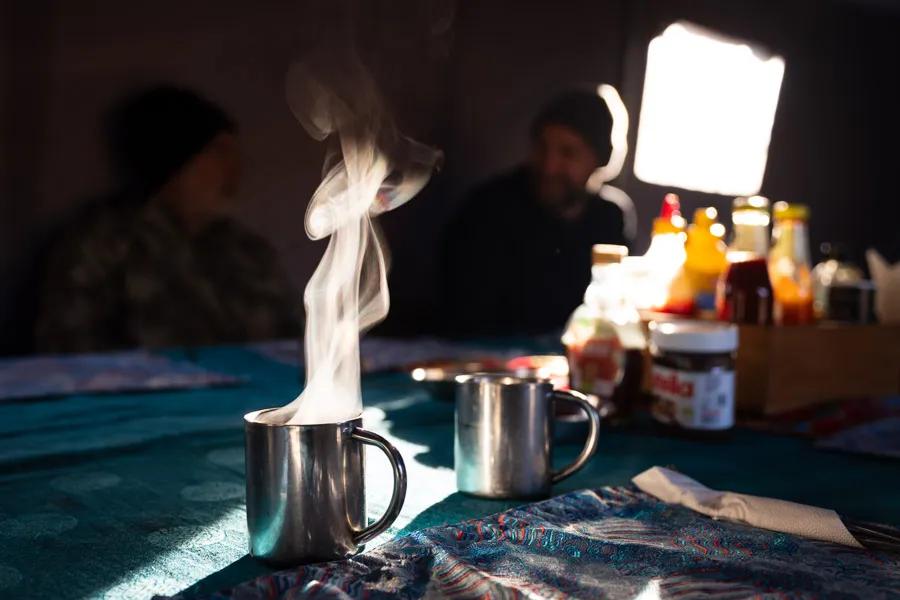

The Fishing
We enjoyed 7 full days of fishing on the trip. When you are camping on the river each day is maximized because just after breakfast the drift boats are a short walk away. Most of the fly fishing in Mongolia is done from comfortable Clackacraft drift boats. There is occasionally time to do a little wade fishing around camp or in a riffle at lunch to target trout and grayling. As good as the trout fishing for the native lenok and Amur trout can be, it is difficult to pass up chasing the massive predators that reside in the river--the taimen. One of the cool things about the middle and lower reaches of the Onon is the abundance of Amur pike. Both the taimen and pike will hit large streamers and most of our group enjoyed targeting the bigger species.
The best rods for this kind of fishing are 8, 9, or 10 weight rods. I prefer to have a floating line on one rod in order to throw surface patterns like large gurglers and poppers. On the streamer rods an intermediate sink tip is helpful. A variety of flies with large 3/0 or 5/0 hooks are preferred. Big taimen love big flies but they can also wear you out casting them all day so a nice balance is some mid-sized flies. With 8 days of fishing, endurance is a big part of the game!
For the amur trout, lenok, and grayling a 5 or 6 weight with floating line is the best option. The trout fishing isn’t that technical and a Montana dry-dropper rig is a perfect setup. Even with some aggressive amur trout over 20” prowling the riffles, they are still not enough to pull your desires away from the massive taimen and pike.
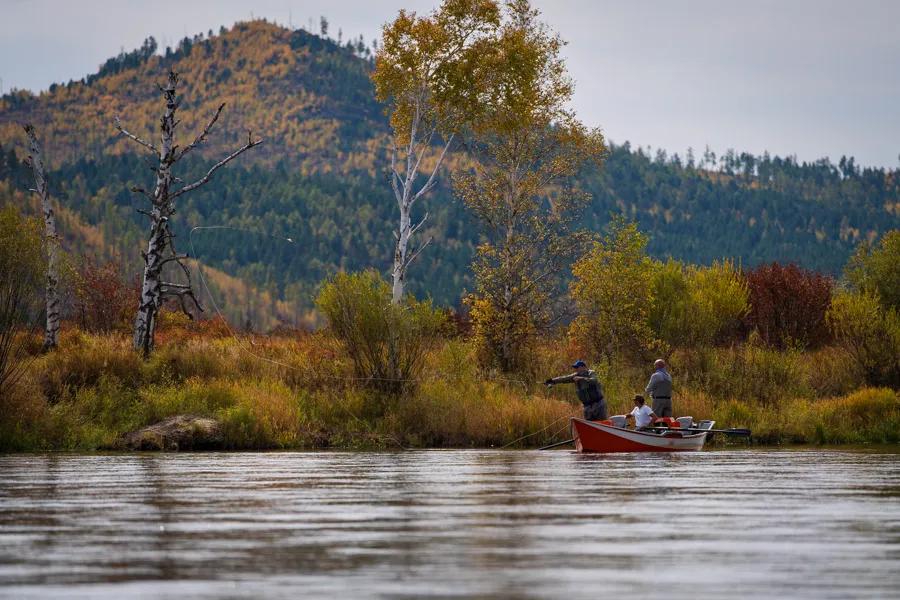
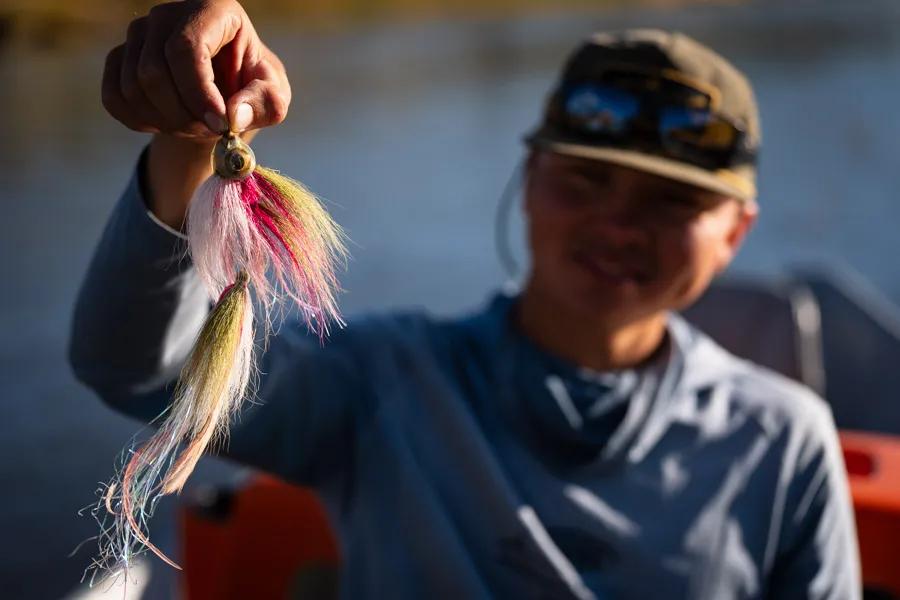
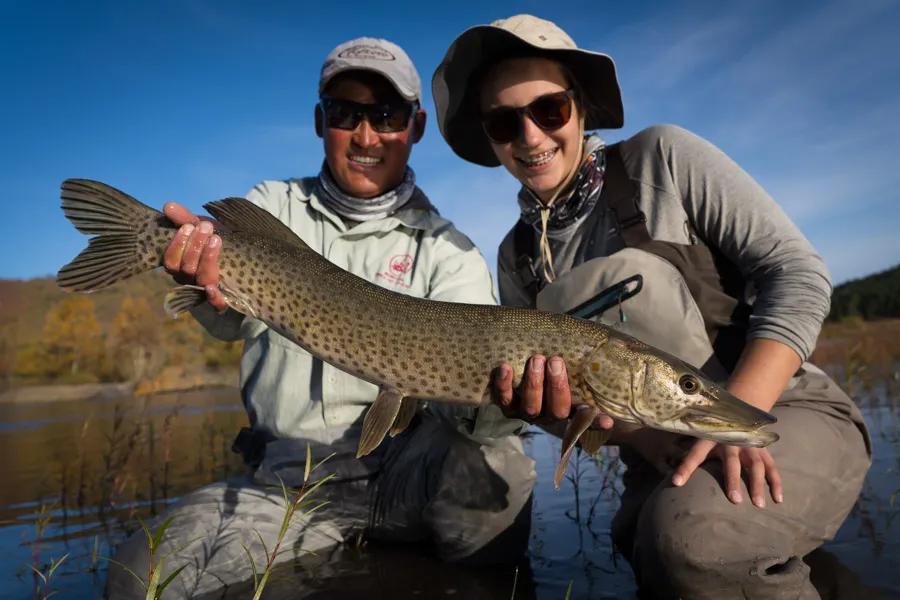
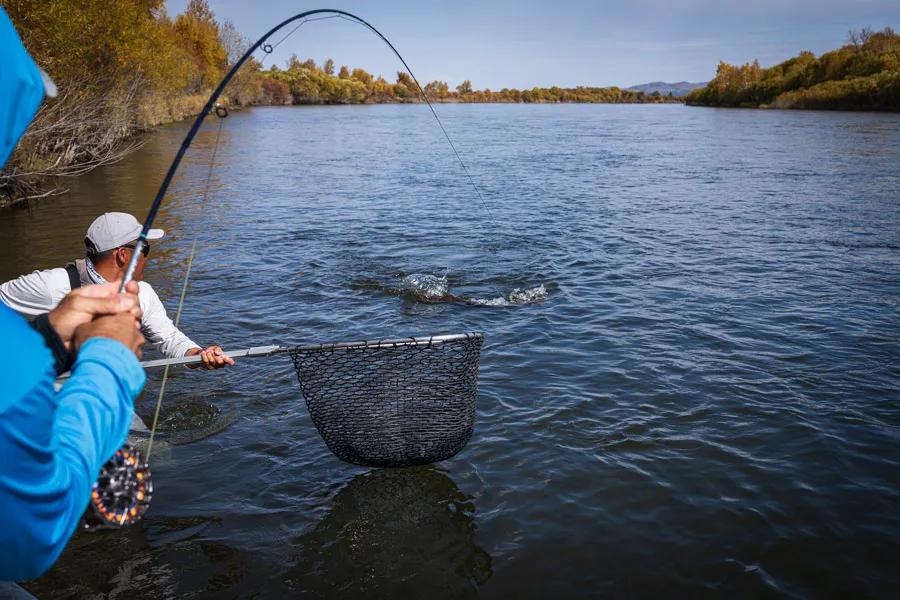

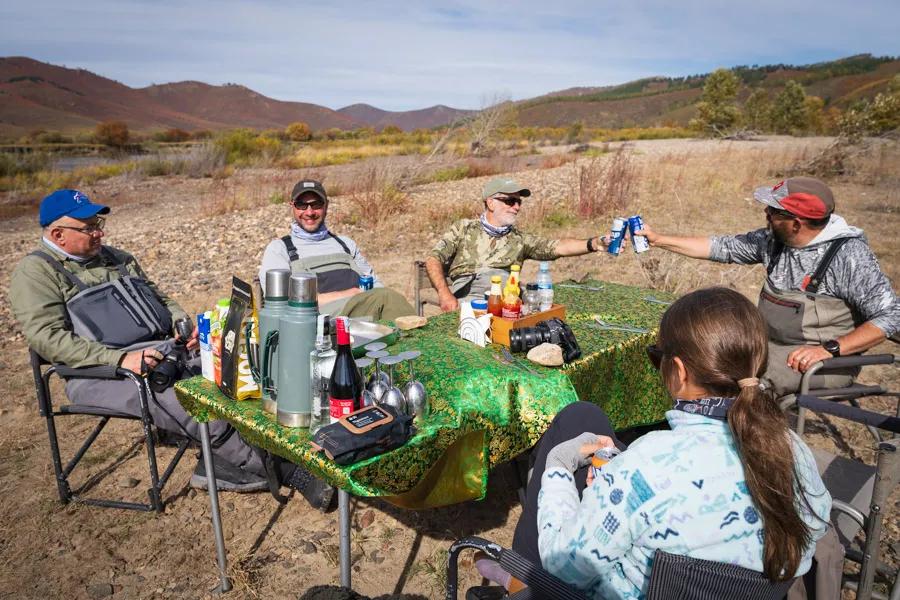
Chasing Taimen
The legendary taimen is definitely the star of the show on a fly fishing trip to Mongolia. The Onon River has a very healthy population of taimen with a few large taimen landed over 50” every season. The record taimen on the river for Mongolia River Outfitters is 59 ½”. Most of the taimen landed are in the high 20s. Any fish over 30” feels pretty darn big and the takes are spectacular. Taimen hold in classic trout water and love to move into fast water when hunting.
Like most large predators they don’t eat all day long every day. Some days it can be very quiet for hours at a time and then the river seems to wake up and you enjoy 2 hours of actively hunting fish. Taimen often wait and rest on large seams below islands and in large tailouts. Sometimes very large fish will be out in the middle of the river in fast water as they cruise and hunt the smaller trout species.
We hit the conditions just right on our trip. The first two days of fly fishing for taimen were a little slow in terms of activity as the river was still dropping and clearing after some heavy rains earlier the previous week. It also takes time for everyone to settle in and learn the nuances of strip-setting and having patience with these massive fish. Often taimen will hit a fly multiple times before getting hooked and it is imperative to keep the fly in the water and keep hitting an aggressive fish with strong strip sets. The excitement and adrenaline rush makes it hard to resist impulsively ripping the fly away. Nailing the strip set on a large taimen takes some practice. Eventually everyone figured out the magic sauce and by the end of the week our group of 6 had collectively landed over 100 taimen!
I managed to land my first taimen over 40” midway through the week while swinging flies in the main river channel while the guide slowly back rowed. I can still feel the hit today--while the fly was swinging in the current it felt like it hit a brick wall as a 42” monster taimen hooked up on the first swipe. After an epic fight and some great netting work by my guide, the fish was brought to hand.
By the end of the week we had collectively landed 4 taimen over 40”. I was fortunate to land a personal best 46” taimen that we spotted from across the river as we watched a large 18” lenok jump out of the water as a huge fish erupted in a toilet bowl flush as the monster taimen was chasing it. We quickly crossed the river and after the 3rd cast the big fish started following and slashing at the streamer I was fishing just below the surface. Eventually the huge fish made an aggressive grab and the line went tight; what a fish!
Later in the trip I had two more scenarios where huge taimen were actively hunting and producing large explosions at the water's surface. One of these fish was hunting in a shallow 2-foot deep riffle. For this fish we rigged up a gurgler and on the first cast the large 38” taimen crushed the surface pattern - amazing!
On our final day of fishing and late in the day as the sun had dropped we encountered another big fish that was pushing water as it hunted. This fish was actively moving along a fast bank and my guide, Soyu, had to work hard to keep the boat in place. While we were targeting that fish another huge taimen erupted in the heart of the run right out in the middle of the mighty river. We crossed the river into a large eddy and back rowed to the top of the run. Soyu positioned the boat along the seam and worked hard on the oars to slow us down as I made long casts across the current. My arm was nearly dead after 8 days of fishing and I had a huge musky pattern tied onto the end of my line, but I knew there was no need to leave any gas left in the tank and I did my best to let ‘er rip. Within the next 30 minutes we landed two big fish including one more 44” monster. What a trip!

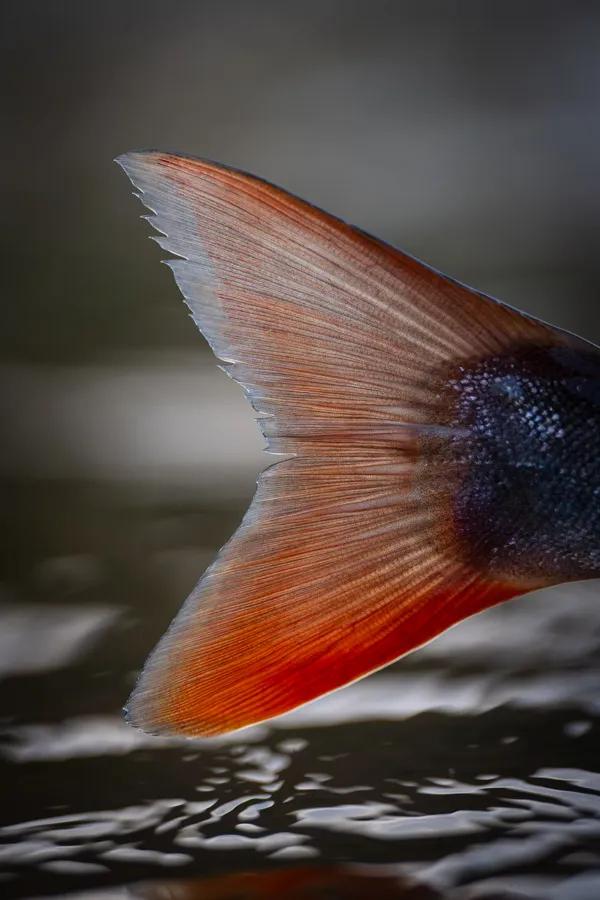
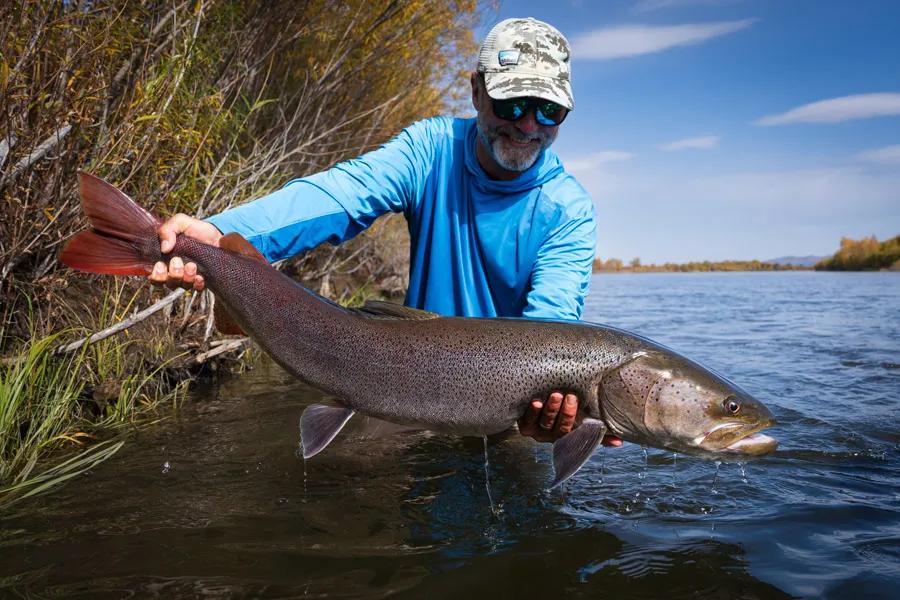


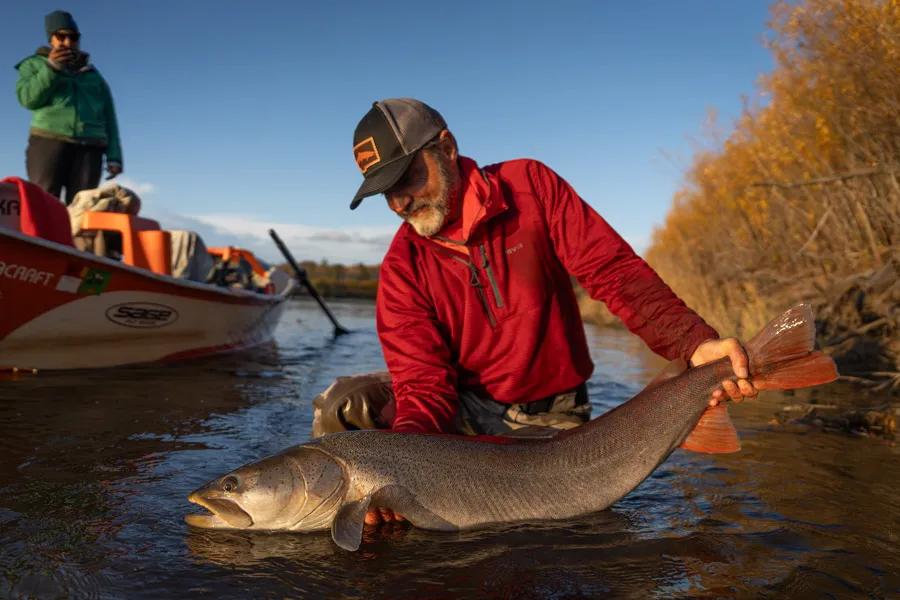
The impressive Amur Pike
On previous trips further up the river system we had encountered an occasional pike. The upper reaches of the river is smaller and there are less of the back channels that pike love. One of the perks of the middle and lower reaches of the river is the increased presence of big pike. The fishery is part of the vast Amur River drainage. The Amur forms just on the other side of the Russian border. and eventually establishes the border between northeastern China and Russia as it makes its way to the Pacific Ocean. The Amur Pike is native to the Amur and its tributaries. The shape and behavior of the pike is similar to a Northern Pike, but the coloration is very different with light colored sides and dark spots.
Fly fishing for pike in Mongolia means to target the slow waters of the back channels as well as some of the slower moving currents in larger eddies. Sometimes we encountered pike while targeting taimen but generally the taimen preferred the strong currents of the main river while the pike were in slower waters. Often we would row up long back arms of the river to intentionally target big pike along banks or weed edges.
We all landed some nice pike in the 30” class. My largest pike of the trip came in right at 40”. These fish are very aggressive and hit the fly like a sledge hammer. Several even put on an aerial display with energetic jumps. Fly fishing for pike in Mongolia is not for faint-hearted anglers or Monday morning quarterbacks.
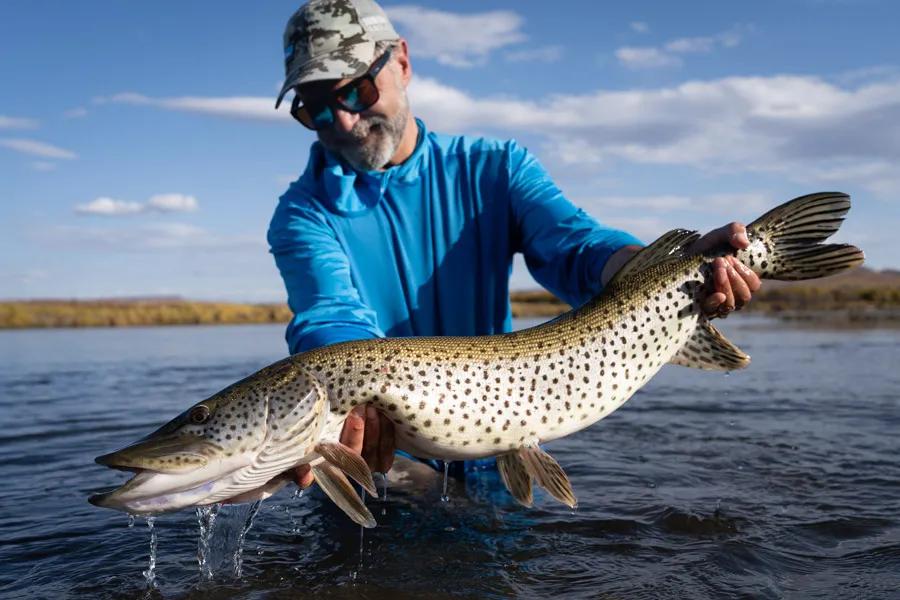

Amur trout, lenok, and grayling
It is quite a novelty to enjoy 8 days fishing where 18” trout are simply considered baitfish. The river would be an amazing fishery if you solely targeted its trout species. But while fly fishing in Mongolia for taimen, there are plenty of other species to pursue. Grayling are very common throughout the fishery, but generally are small. Most days 6-11” grayling can be found rising in the shallow tail-outs of runs and can be targeted with smaller dry flies such as a size 16 adams. The lenok and Amur trout are occasionally caught on the huge streamers or big poppers we use for the taimen. The trout species love the swifter water along banks and classic dry dropper rigs are a good way to target them. The uppermost river stretches have excellent Amur trout habitat but on the Lower Onon most of the Amur trout are encountered near some of the tributaries that come in. Andy Maciejewski was lucky enough to land a large 22” Amur trout midway through our trip.
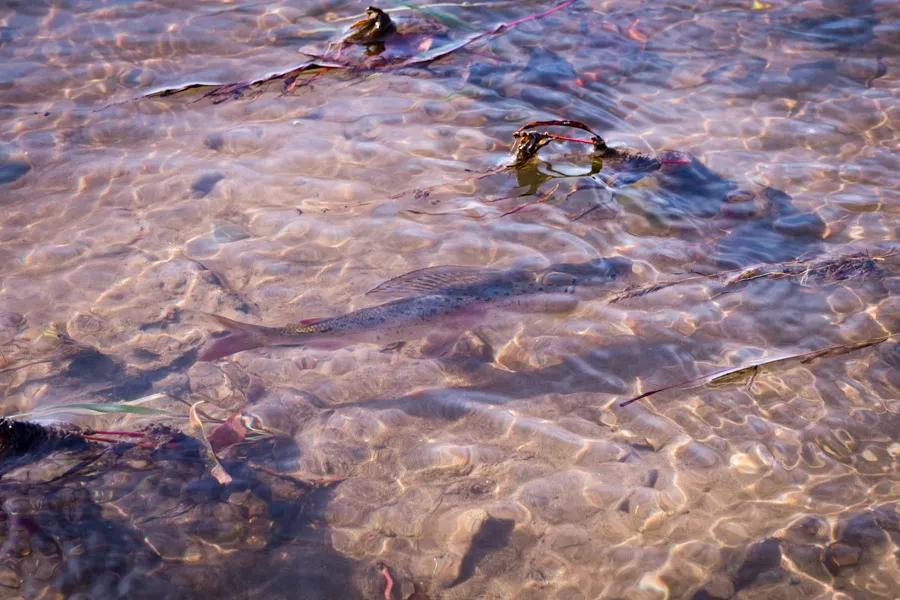
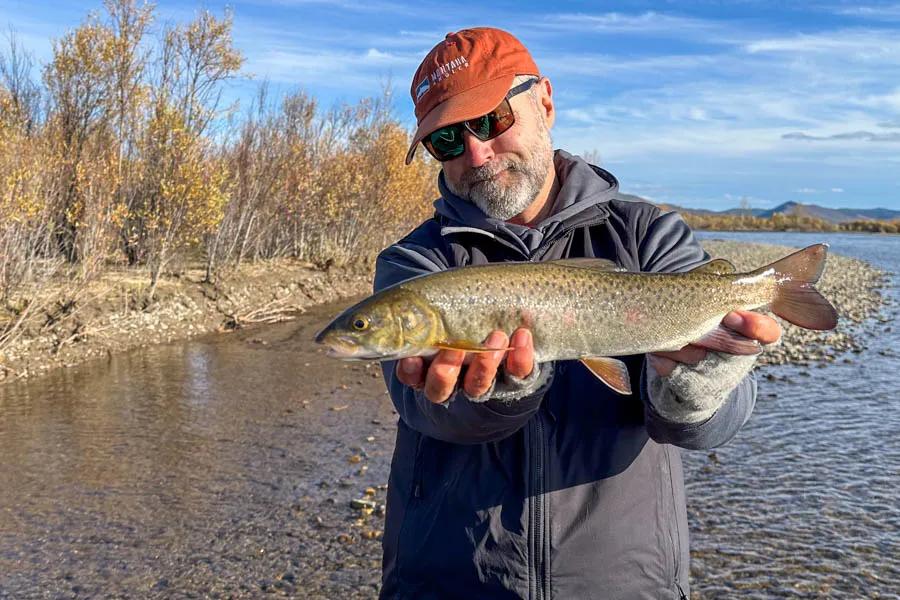

We’ll be back!
Unfortunately there is not enough time in a lifetime of fly fishing to sample all of the special fisheries on this earth. When planning hard earned fishing trips there is always a difficult choice to be made between exploring a new location vs. visiting a location that demands a return visit. Mongolia is definitely a place that is on my "favorites" list that I hope to continue making multiple return visits to in the future. I am a trout fisherman at heart and the opportunity to explore these incredibly remote and unpressured fisheries while casting to the world’s largest freshwater trout species is a very difficult scenario to upstage. As the world gets busier and busier it is so refreshing to be so completely unplugged.
There is something so incredibly magical about the slow pace of life as you spend day after day floating down the same river. When you toss in incredible guides, great food, and spectacular scenery it is no wonder that all of us had a perma-grin on the long drive back to Ulaanbaatar after the trip.
We will be returning to Mongolia to host trips in both 2026 and 2027.
Interested in joining on the next trip?
Click here for details on our 2026 hosted trip!
